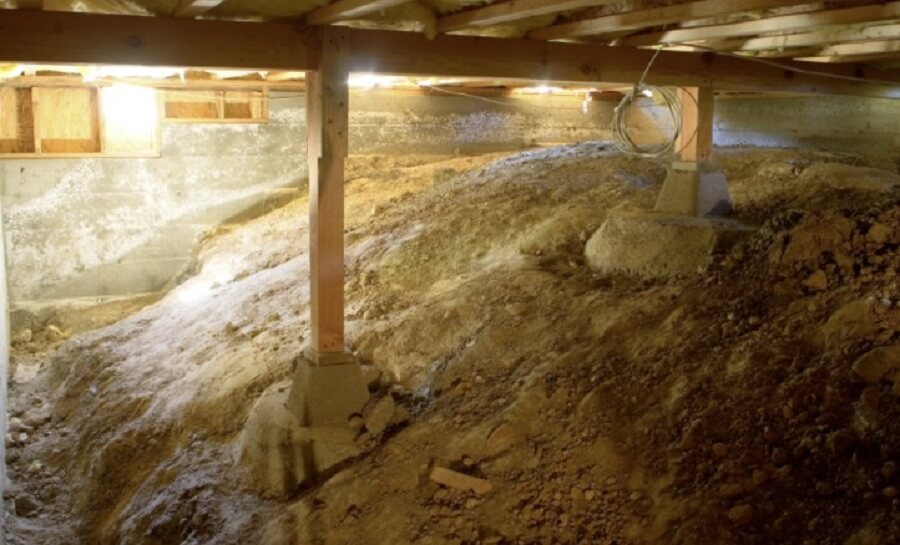Getting rid of the terrible smell from your crawl space can be challenging. While the best way of eliminating the odor is to determine the cause, this can be hard to do in a crawl space.
Things like rodents, foreign objects, dust mites, mold, mildew, sewage pipe leaks, decaying building materials, stagnant water, and high humidity can all be sources of house odor, especially after crawl space encapsulation.

You can remove crawl space odors permanently using a dehumidifier, ozone generator, mothball, or deodorizer. Also, consider using products like Gonzo Odor Eliminator or Van Den Heuvels R86, which will work on smells like mildew, rot, urine, vomit, mold, and more.
If you want a natural solution to get rid of the musty smell in the crawlspace, you can apply a mix of vinegar and baking soda to the affected areas.
Contents
Is it normal for a crawl space to smell musty?
It is common for some crawl spaces to smell musty. However, the exact way that happens will vary based on whether you have sealed or vented the area.
In most cases, the primary reason for the stench is moisture. When warm and humid air passes through the crawl space, it comes into contact with a cold surface and condenses. After a while, the damp accumulates and forms mold, rot, and a musty smell.
5 ways to get rid of crawl space odors permanently
Here’s a detailed breakdown of different methods for eliminating crawl space odors.
1. Using an ozone generator
Ozone generators work by producing ozone gas which dissipates in the air to remove unpleasant smells caused by smoke, pets, musty basement, paint, among others. If you don’t have an ozone generator, consider getting the Enerzen 11,000mg.
Follow these steps to get rid of stenches in the crawl space using an ozone generator.
- Clean up the basement to remove any visible sources of odors.
- Set the timer on the generator using the control knob. Check the manufacturer’s instructions for guidelines on time.
- Leave the room before it starts producing ozone and allow it to run for at least two hours.
- Keep the windows and doors open and wait at least 60 minutes after ozone generation ends to step inside.
- Repeat treatment once every few months if you notice lingering odors in the crawl space.
Before using the ozone generator, ensure nobody is at home because the gas produced is toxic.
Secondly, if moisture is the primary source of the smell, get rid of it first. It will cause the formation of mold and mildew, even after using an ozone generator. Understand that the more humid the environment, the less effective the ozone generator.
2. Using odor eliminators
The best odor eliminators that are worth considering include Gonzo Odor Eliminator and Van Den Heuvels R86. They work by absorbing musty smells and moisture from surfaces without covering them up.
Here is how to use the Gonzo Odor Eliminator rocks:
- Remove the layers of plastic wrap covering the net bag.
- Place the net containing the odor eliminating rocks in the crawl space near the area where the smell exists.
- Allow the product to work for at least eight hours.
If you do not prefer Gonzo Odor Eliminator, consider using Van Den Heuvels R86. It comes in the form of crystals, which you can use in wet or dry applications.
Here is how to use it:
- Sprinkle the crystals directly on the surface of the odor.
- Wait for at least 20 minutes for the product to absorb the smells.
- Clean, vacuum, or sweep up the crystals.
Alternatively:
- Mix R86 in a ratio of two tablespoons per quart/1 cup per gallon in a spray bottle.
- Spritz surfaces in the crawl space, including walls and pipes.
If the room above the crawl space smells, the R86 will remove the stench through absorption without covering it up.
3. Using a dehumidifier
A crawl space dehumidifier works by removing moisture from the air. As a result, it helps to curb the growth of dust mites and mold.
A dehumidifier is useful if there is a build-up of humidity in the basement. When in operation, it will draw air over cold coils, condense out moisture, and then pass warm air over the area.
The best dehumidifiers for basement moisture is the Aprilaire 1820 Pro or the Waykar 2000 Sq. Ft dehumidifier, if you need a portable one.
Here is how to use it:
- Place the dehumidifier in the crawl space (in case of a portable one) and turn it on.
- Adjust the settings based on the manufacturer’s recommendations
- Set the optimal relative humidity to between 30 and 50 percent.
- Allow it to run through several cycles.
Place the dehumidifier in a way that allows air to flow in and out of the crawl space freely. We’ve also provided tips for running a humidifier longer without spending much on electricity.
4. Using a deodorizer bomb
A crawl space deodorizer bomb releases a mist or an ultrafine disinfectant fog into the air to destroy odors. The best products are the Odoban One Shot Fire or the Big D fogger 344. Here is how to use it:
- Prepare the crawlspace by removing primary sources of odors.
- Press and lock the actuator on the deodorizer bomb.
- After you activate the fogger, leave the area.
You will have to wait at least one hour for the treatment to work.
5. Using vinegar and baking soda
Vinegar and baking soda offer a natural way of getting rid of odors from spaces. Here is how to use them:
- Pour one cup of vinegar and one cup of baking soda into a bowl.
- Wait for the fizzling to stop.
- Add three cups of water to the mixture.
- Store the solution in a spray bottle and spray it in the crawlspace.
- You can also scrub down surfaces in the affected area to eliminate the odors.
Alternatively, use the two products separately. In this case, sprinkle the baking soda in the crawlspace and leave it for at least two days before cleaning the area.
Conclusion
You can get rid of crawl space odors in different ways. Some methods to consider include using a dehumidifier to eliminate moisture, ozone generator, or odor-eliminating crystals or rocks. If you want a natural crawl space odor neutralizer, use baking soda or vinegar.
